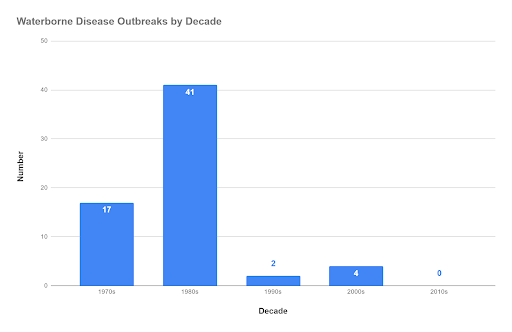Note: this article is part 2 of a series to read part one, please visit the Aqua Talk article posted on March 9, 2022
In 2020 EPA began stakeholder engagement as part of its review of Microbial/Disinfection Byproducts (M/DBP) Rules. The M/DBP rules are an important suite of drinking water rules designed to protect the public from the acute risks associated with waterborne disease outbreaks by requiring strong treatment and disinfection. However, the rules also try to balance the chronic health risk associated with cancer from certain disinfection byproducts. The Safe Drinking Water Program (program) engaged in this process and shared some of our thoughts and experiences with these rules.
In a prior Aqua Talk Article we briefly shared our overall input to EPA on a variety of topics including evaluating sources of drinking water that could be Groundwater Under the Direct Influence (GWUDI) of surface water and disinfection treatment evaluations, risks associated with storage tanks and our approach to requiring disinfection residual throughout distributions systems in Colorado. EPA asked us to provide more detailed information regarding our experience with preventing microbial contamination with focus on disinfection, storage tanks and cross connections. In this article we summarize the input provided.
The Alamosa waterborne disease outbreak in 2008 catalyzed our efforts to reduce exposure to pathogens in tap water. Alamosa had deep wells and no disinfection in place while serving 8,900 people. One thousand three hundred (1,300) people were estimated to have been sick during the outbreak. Twenty people were hospitalized and one person died. Twenty six (26) percent of those that were ill reported symptoms lasting a year and a half later. It was also estimated that 40 percent of the infants in town got sick. In addition, the outbreak caused severe impacts to the economy, and numerous businesses closed. While the cause of the outbreak was most likely animal waste entering cracks or holes in a storage tank, calculations showed that it likely took very little waste to contaminate the entire water system. Thankfully Alamosa has since made improvements to their water system and now provides adequately disinfected drinking water and continues to work to ensure the safety and health of consumers. However, with our goal to minimize waterborne disease risks statewide, we tackled disinfection and backflow prevention in addition to storage tanks.
Beginning in 2014, the program worked with stakeholders to address these issues in our Colorado Primary Drinking Water Regulations (Regulation 11). Key changes to regulations involved:
- Modified disinfection rules drastically reducing waivered systems
- Implemented minimum disinfectant residual of 0.2 mg/L
- Developed special rules for hand-pumped systems and water haulers
- Developed a special rule requiring routine and comprehensive storage tank inspections
- Updated and improved cross connection control rules
We shared with EPA some of the key results we have seen because of these changes, and will share some of that here.
Regarding disinfection waivers, the program has been regularly and thoroughly reviewing disinfection waivers and withdrawing waivers where needed, especially in response to positive total coliform or E. coli results in finished water. The chart below shows the number of public drinking water systems waivers has declined since 2007. By the end of 2022, we expect that there will only be two active disinfection waivers in Colorado. Overall, we believe that this decline in disinfection waivers better protects public health as the added pathogen contamination barrier of continuous disinfection is in place.
For the storage tank rule, we have about 1,400 storage tanks in the state subject to this rule. From April 2016 to August 2020, we issued about 300 violations of the storage tank rule and identified about 400 significant deficiencies involving storage tanks. Some of the specific items observed have included dead rodents in tanks as well as live snakes, and bullet holes. The most common concerns involve issues with hatches and vents. The good news is that well over 90% of these issues have been resolved. We believe this represents a significant improvement in risk reduction associated with storage tanks in Colorado as a result of implementing this rule.
We updated and/or developed handbooks related to water haulers and public water systems that operate primarily hand-pumped wells to include disinfection and operational practices. We also require that disinfectant residual in distribution systems be monitored and reported to the division. If values fall below 0.2 mg/L, then a treatment technique violation requiring tier two public notice can result. We also strengthened our ability to oversee the cross connection control rule and required that distribution systems be specifically surveyed for cross connections. Since 2016, hundreds of cross connection deficiencies and violations have been identified and corrected.
We believe that the overall risk reduction resulting from these efforts has been substantial. We have not had a waterborne disease outbreak at an active public drinking water system in Colorado since 2008. But waterborne disease outbreaks are tricky to confirm, so we also look at the number of E. coli violations. We think that looking over the course of decades is best to observe trends. Below are two charts showing both waterborne disease outbreaks and E. coli violations over the last few decades. As you can see, these trends show very positive results!
This information was shared with EPA in 2021. We do not know exactly how EPA will use this information or the ultimate direction they will take with updating the M/DBP rules. We will keep you informed, and obviously you will have the opportunity to engage with EPA in this process as well. It will be the mid-2020s before EPA fully updates the M/DBP rules, but these are highly impactful rules and we encourage water systems to be aware of and engaged in the process. Thank you.
➽ Ron Falco, P.E. Safe Drinking Water Program Manager


